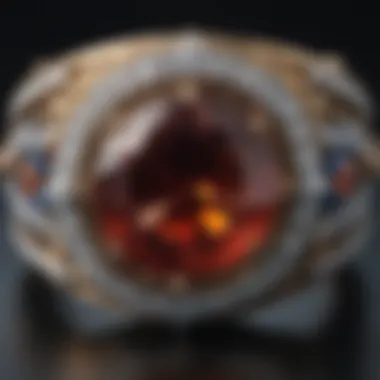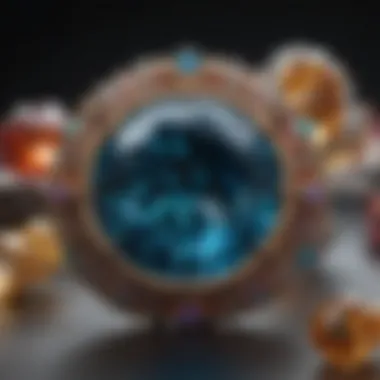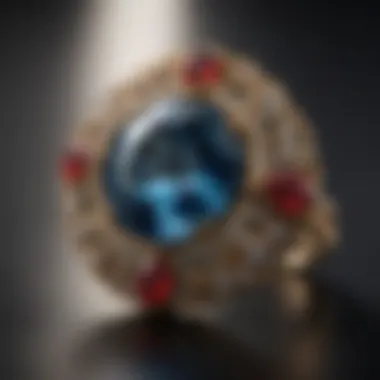Exploring American Jewelry Manufacturers: Craft and Legacy


Intro
The realm of American jewelry manufacturing represents a unique confluence of craftsmanship, innovation, and a rich legacy that continues to shape the industry. From the early colonial days to the present, American jewelry has evolved alongside technological advancements, shifting consumer preferences, and societal trends. This narrative is not merely about adornment but encapsulates the artistry, ethos, and diverse materials that define this sector.
As we delve into this exploration, we will examine how American manufacturers have adapted and thrived within a dynamic global landscape. Key players in the industry have maintained traditional skills while leveraging modern technologies to enhance design and production methods. Moreover, the discussion will, highlight challenges such as competition from overseas markets and the increasing demand for sustainable practices. Understanding these dynamics is crucial for anyone interested in the world of jewelry—be it enthusiasts, collectors, or designers.
The emotional connection consumers have with jewelry makes it more than just an accessory; it often represents milestones, memories, and identities.
In the following sections, we will dissect various elements that contribute to the American jewelry narrative, especially focusing on the craftsmanship and innovations that set these manufacturers apart from others globally.
Overview of American Jewelry Manufacturing
The realm of American jewelry manufacturing serves as a cornerstone in the landscape of global craftsmanship. It embodies centuries of tradition, skilled artisans, and a commitment to innovation. The significance of understanding this industry lies in recognizing the unique characteristics that differentiate American jewelry from other global markets. The article aims to reveal the intricate interplay between history, craftsmanship, and technological advances within this sector.
Historical Context
The roots of American jewelry manufacturing can be traced back to indigenous craftsmanship, with Native American tribes creating unique adornments using materials like silver, turquoise, and semi-precious stones. This early influence laid the foundation for future artisans.
During the 19th century, the discovery of gold and silver in America sparked a boom in production. Factories emerged, and skilled craftspeople adapted to industrial methods while maintaining a dedication to artistry. Notably, brands such as Tiffany & Co. and Cartier began establishing a reputation during this period, with a focus on luxury and sophistication.
The early to mid-20th century was marked by significant innovation. Jewelers embraced new materials and techniques, integrating gemstones from various sources around the world. This era also witnessed the rise of Art Deco, a movement that emphasized geometric designs and bold colors, shaping the aesthetic preferences of many consumers.
Modern Industry Landscape
Today, American jewelry manufacturing is a vibrant and competitive field. The industry has adapted to various trends, including a migration towards sustainability and ethical sourcing of materials. Many manufacturers emphasize craftsmanship and unique designs, appealing to a discerning consumer base.
In the current market, established brands coexist with emerging designers who bring fresh perspectives and innovative ideas. Social media and e-commerce have reshaped how jewelry is marketed and sold, allowing artisans to reach global audiences directly. This shift represents a significant change from traditional retail models and highlights a potential future for the industry.
"The American jewelry industry is a blend of tradition and modernity, where legacy meets innovation."
As we examine the subsequent sections, it will be vital to further dissect elements such as craftsmanship, key players, and the impact of consumer behavior on the modern landscape. Each aspect offers insight into a complex industry, revealing how historical influences continue to shape modern practices.
Key Players in the Industry
The Key Players in the Industry represent the backbone of the American jewelry manufacturing sector. Their influence shapes market trends and consumer behaviors. Recognizing the major manufacturers not only highlights their craftsmanship but also underscores their role in innovation and sustainability efforts, which are increasingly vital to modern consumers. These players create a benchmark for quality and design, pushing boundaries while also preserving traditional techniques. The competitive landscape provides insights into how these companies navigate challenges and seize opportunities in the evolving market.
Notable American Manufacturers
Several prominent names stand out in the American jewelry manufacturing scene, each contributing uniquely to the industry. One such company is Tiffany & Co., known for its iconic designs and exceptional craftsmanship. Established in 1837, Tiffany has become synonymous with luxury and quality. Their use of innovative materials and timeless styles has set a standard that influences other manufacturers.
Another significant player is David Yurman. Known for its distinctive cable designs, this brand marries artistic vision with quality craftsmanship. The focus on designing unique pieces that resonate with consumers has made David Yurman a leader in the luxury jewelry market.
Harry Winston, often referred to as the "King of Diamonds," provides high-quality diamond pieces that attract collectors worldwide. Their commitment to sourcing rare stones and exquisite designs ensures their position in the upper echelon of the jewelry market.
Other notable manufacturers include Cartier, Bulgari, and Boucheron, each showcasing exceptional heritage and innovative designs that highlight the evolving nature of jewelry craftsmanship in America. These brands not only cement their legacy through their work but also inspire emerging designers and brands.
Emerging Brands and Designers
The landscape of American jewelry is continually evolving with the rise of emerging brands and designers. These new players often introduce fresh perspectives and innovative methods to traditional jewelry-making practices. For instance, brands like Mejuri cater to a younger demographic, embracing direct-to-consumer strategies. Their focus on ethical sourcing and sustainability resonates strongly with today's conscience consumers.
Similarly, Catbird, an artisanal brand based in Brooklyn, emphasizes handmade jewelry using ethically sourced materials. This approach reflects a shift towards sustainability and artisanal craftsmanship, appealing to a market that values transparency.


Jewelers of America, a trade association, supports these new designers by providing resources and networking opportunities. By fostering innovation, these emerging brands and designers contribute significantly to the diversity and creativity present in the American jewelry industry.
The interplay between established manufacturers and new entrants fosters a vibrant environment where craftsmanship, innovation, and cultural influences can thrive together, ultimately enhancing the legacy of American jewelry.
Craftsmanship in American Jewelry
Craftsmanship in American jewelry represents not just skill but a commitment to artistry and precision. The attention to detail is crucial as it creates pieces that are not only visually stunning but also reliable and enduring. American jewelry manufacturers often pride themselves on their superior craftsmanship, using advanced techniques and high-quality materials. This level of dedication reflects a deeper connection to cultural identity and individuality.
Materials Used
The choice of materials is a defining aspect of American jewelry craftsmanship. Artisans often utilize a variety of materials such as gold, silver, platinum, and gemstones.
- Gold: Its malleability and luster make it ideal.
- Silver: Used widely for its affordability and versatility.
- Platinum: Known for durability, it caters to high-end markets.
- Gemstones: Diamonds, sapphires, and semi-precious stones often enhance the design.
Each material showcases unique properties that artisans mold into intricate designs. Furthermore, many manufacturers prioritize ethically sourced materials. This is in response to growing consumer demands for sustainability.
Techniques and Innovations
Techniques in jewelry making evolve, providing manufacturers with new tools and methods to enhance their products. Traditional methods like weaving, soldering, and casting are being paired with innovative technology to create modern masterpieces.
- Handcrafting: Many brands still valuate manual production due to its artistry.
- Computer-Aided Design (CAD): Designers use CAD to create intricate patterns before fabrication. This ensures precision and the ability to experiment without waste.
- 3D Printing: This innovation allows for the rapid creation of complex designs. It removes limitations imposed by traditional manufacturing techniques, opening the door to more creative expressions.
"The intersection of tradition and technology is reshaping what is possible in jewelry design today."
These advancements not only improve design but also streamline production processes. This synergy of craftsmanship and innovation positions American manufacturers at the forefront of the global jewelry market.
Cultural Influences on Jewelry Design
Understanding the cultural influences on jewelry design is essential in comprehending how American jewelry has evolved and continues to resonate with consumers. The significance of this topic lies in its ability to showcase the historical and social contexts that shape design choices, materials, and techniques used by manufacturers. As American society becomes increasingly diverse, jewelry design reflects this complexity by integrating various cultural elements, thus enriching the overall aesthetic and meaning of the pieces produced.
American Art Movements
American art movements have played a crucial role in shaping jewelry design. For example, the Art Deco period of the 1920s introduced geometric shapes and vibrant colors, influencing jewelers to experiment with novel materials and bold designs. Art Nouveau, which preceded Art Deco, emphasized natural forms and intricate craftsmanship. This focus encouraged jewelers to explore organic shapes and flowing lines, resulting in pieces that conveyed a sense of harmony with nature.
Some of the noteworthy American art movements that impacted jewelry design include:
- Art Deco: Characterized by bold lines, bright colors, and geometric patterns.
- Art Nouveau: Focused on nature-inspired designs and intricate detailing.
- Pop Art: Introduced elements of popular culture, leading to kitsch and playful designs.
Regional Styles and Identity
In addition to broader art movements, regional styles and identity significantly impact jewelry design across America. Different parts of the country have their unique traditions and aesthetics, often shaped by the history and culture of their inhabitants. For instance, Southwest Native American jewelry is known for its intricate silverwork, turquoise, and cultural symbolism, reflecting the region's rich heritage.
Understanding regional influences can provide a deeper appreciation for American jewelry. Here are a few examples:
- New England: Often incorporates colonial themes and craftsmanship techniques from early American settlers.
- California: Frequently features bold and innovative designs, inspired by the vibrant lifestyle and diverse culture of the state.
- Texas: Known for western themes and the use of leather and metal, often drawing on cowboy culture.
"Jewelry is a reflection of culture, identity, and time. It serves as a bridge connecting personal stories with collective history."
By examining the impact of art movements and regional identities, one gains a clearer understanding of the diverse influences that inform American jewelry design. As these elements continue to evolve, they not only preserve history but also invite new interpretations that speak to contemporary consumers.
The Role of Technology


Technology plays a crucial role in reshaping the American jewelry manufacturing landscape. It influences design, production efficiency, marketing, and customer engagement. As manufacturers adapt to evolving technologies, they are better positioned to meet consumer demands and stay competitive in a global market.
One of the most significant changes technology has brought is in how jewelry is marketed and sold. The rise of digital platforms enables manufacturers to reach customers directly, bypassing traditional retail channels. This shift allows for a more personalized shopping experience, catering to the specific preferences of individual buyers.
Digital Marketing Strategies
Digital marketing strategies have become essential for American jewelry manufacturers. These strategies focus on building an online presence through websites and social media. They utilize content marketing, search engine optimization (SEO), and targeted advertising to attract customers.
Some effective digital marketing tactics include:
- Social Media Engagement: Platforms like Instagram and Pinterest showcase jewelry in visually appealing ways. This not only attracts potential buyers but builds a community around brands.
- Influencer Collaborations: Partnering with influencers helps manufacturers reach new audiences. Influencers often have loyal followers who trust their recommendations, leading to increased brand awareness.
- Email Marketing: Regular newsletters keep customers informed about new collections and promotions. Personalization in these communications can further enhance customer loyalty.
The integration of technology into marketing operations streamlines these processes, making them more efficient and cost-effective.
3D Printing and Jewels
3D printing revolutionizes the way jewelry is designed and produced. This technology enables manufacturers to create intricate designs that were previously difficult to achieve. Using digital designs, a 3D printer can produce prototypes quickly. This rapid prototyping allows for immediate feedback and adjustments, significantly speeding up the design process.
The benefits of 3D printing in jewelry manufacturing include:
- Customization: Consumers increasingly seek unique pieces. 3D printing makes it possible to produce custom designs tailored to individual preferences.
- Reduced Waste: Traditional methods often result in surplus materials. 3D printing is more efficient, minimizing waste during production.
- Cost-effective Prototyping: Manufacturers can experiment with numerous designs without incurring high costs.
Consumer Trends
Understanding consumer trends is essential in the realm of American jewelry manufacturing. It allows manufacturers to adapt to shifting markets and meet the evolving desires of consumers. By examining these trends, we can see a clear connection between what consumers want and the methods manufacturers employ. This section highlights key elements that define current consumer behavior and preferences in the jewelry sector.
Shifts in Consumer Preferences
Recent years have witnessed notable shifts in how consumers approach jewelry purchases. The rise of digital platforms has changed not only the way jewelry is marketed but also how it is sold. Younger generations tend to value personalization and unique designs, often favoring bespoke pieces over mass-produced items. The preference for individuality is leading customers to seek out brands that offer customization options.
Additionally, there is an increased focus on authenticity. Shoppers are more inclined to purchase from brands that tell a story, whether based on heritage or unique craftsmanship. Reports suggest that brands promoting their distinctive origins and methods attract a loyal consumer base.
"Today's consumers are not just buying jewelry; they are buying a piece of a story, a reflection of their identity, and a commitment to values they care about."
Demand for Sustainable Practices
Alongside personalization and storytelling, sustainability has become a significant factor in consumer decision-making. Many buyers today prioritize eco-friendly practices and ethically sourced materials. They are increasingly aware of the environmental impact of their purchases. This awareness prompts them to favor brands that engage in sustainable practices, such as using recycled metals or ethically sourced gemstones.
Manufacturers are responding to this trend by emphasizing their sustainable methods in marketing campaigns. For instance, brands like Brilliant Earth have gained recognition for their commitment to ethically mined diamonds and lab-created stones. Other manufacturers are adopting sustainable supply chains, which not only appeal to eco-conscious consumers but also help improve overall operational efficiency.
In summary, recognizing these consumer trends allows American jewelry manufacturers to stay relevant. Understanding shifts in preferences and the demand for sustainability will significantly influence future strategies and product offerings. As manufacturers align with these trends, they not only improve customer satisfaction but also contribute positively to broader social and environmental goals.
Challenges Faced by Manufacturers
The jewelry manufacturing industry in America faces a myriad of challenges that directly impact its growth and sustainability. Understanding these challenges is crucial for anyone involved in or passionate about the study of jewelry design and production. Manufacturers are continuously adapting to changing market conditions while striving to maintain their craftsmanship and innovation.
Supply Chain Issues
Supply chain complexities are a primary concern for American jewelry manufacturers. The journey from raw materials to finished products involves numerous stages, each with its own set of variables. Factors such as sourcing gemstones and metals can complicate matters. Global events, such as the pandemic or geopolitical tensions, can disrupt supply routes, making materials hard to obtain. Additionally, fluctuating prices of precious metals can affect overall production costs. Manufacturers often find themselves in a position where they must quickly adjust to maintain profitability and ensure the quality of their products.
- Rising Costs: Costs associated with shipping and materials are increasing. This places pressure on the margins for many manufacturers.
- Sourcing Challenges: Responsible sourcing of materials is essential. However, it can be difficult to trace the origin of specific gems, which raises ethical concerns for many consumers.
- Logistical Hurdles: Depending on the complexity of the design, coordinating the delivery of components can become a logistical nightmare.


These supply chain challenges require innovative solutions, such as diversifying suppliers or investing in local sourcing. Manufacturers engaging in transparent practices and secure supply chains position themselves as reputable brands in a competitive market.
Competition with International Markets
American jewelry manufacturers face intense rivalry from international markets. Countries with lower labor costs can produce similar products at a fraction of the price. This presents a significant challenge for U.S. manufacturers focused on quality and craftsmanship.
Moreover, consumers today have access to a global market through e-commerce platforms. They can easily compare products across various countries, making price a vital factor in their purchasing decisions.
To remain competitive, American manufacturers must emphasize aspects such as:
- Unique Design Aesthetic: Many consumers gravitate toward unique, bespoke designs that reflect individuality. This is an area where American designers can stand out.
- Quality Assurance: Emphasizing craftsmanship and the quality of materials can attract consumers willing to pay a premium.
- Sustainability Principles: There is an increasing consumer demand for sustainable practices in jewelry making. Brands that adopt and market these principles can capture a more discerning customer base.
It is essential for American manufacturers to find their niche within the global market. Collaborating with artists and designers can lead to innovative products that align with consumer values and stand apart from mass-produced alternatives.
"The strength of American jewelry lies in its craftsmanship and the story behind each piece. However, these challenges must be addressed to sustain and enhance its legacy."
Future of American Jewelry Manufacturing
The landscape of American jewelry manufacturing is on the brink of significant transformation. Understanding the future of this industry provides insight into potential shifts in craftsmanship, technology, and consumer preferences. As factors such as globalization and technology continue to evolve, American manufacturers will face both opportunities and challenges. Navigating these elements will play a crucial role in shaping the industry.
Technological advancements, changing consumer demands, and a growing emphasis on sustainability are vital areas that influence the future trajectory of American jewelry manufacturing. These trends will not only redefine craftsmanship but also impact market dynamics on a larger scale. Let's explore these aspects further.
Emerging Trends
Several emerging trends highlight the direction of American jewelry manufacturing. First, there is an increasing focus on customization. Consumers are seeking unique pieces that reflect their personal style. This demand leads manufacturers towards tailored solutions, allowing buyers to select materials, designs, and finishes that resonate with them.
Additionally, the sustainability movement is gaining momentum. Many brands are adopting ethical sourcing practices, using recycled metals and conflict-free stones. This shift is not just a trend but rather a necessary response to a more socially conscious customer base. Moreover, transparency in supply chains has become a priority, so consumers are more informed about where their products originate.
Online retail is also evolving, with more companies building robust e-commerce platforms. Social media engagement plays a key role in marketing, as brands utilize platforms like Instagram and Facebook to reach their audiences directly. This approach fosters a community around brand storytelling, allowing consumers to connect with the heritage and craftsmanship behind each piece.
"The push for customization and sustainability in jewelry not only respects tradition but also adapts to modern consumer values."
Anticipated Innovations
Anticipated innovations in the American jewelry sector are equally exciting. One notable area is the use of 3D printing technology. This method allows designers greater flexibility, enabling them to create highly intricate designs that traditional methods may not support. It also streamlines production processes, reducing both time and material waste.
Another innovation is the synthesis of natural and lab-grown gemstones. As consumers become more educated on the differences, there is a growing acceptance of lab-created stones. This creates opportunities for jewelers to offer an expanded range of options while maintaining ethical standards in sourcing.
Furthermore, advancements in augmented reality (AR) offer potential for enhancing the shopping experience. Consumers may soon try on pieces virtually, bridging the gap between online and in-store experiences. This technology not only enhances consumer engagement but also reduces the return rates commonly associated with online purchases.
As the industry adapts to these emerging trends and innovations, American jewelry manufacturers will continue to play a significant role in the global market. The combination of craftsmanship, contemporary practices, and a commitment to sustainability will define the future of American jewelry.
The End and Final Thoughts
The landscape of American jewelry manufacturing stands as a testament to the dynamic interplay between tradition and innovation. Throughout this article, we have traversed the historical depth and complexity of this industry, detailing how craftsmanship has evolved with technological advancements. The importance of understanding this evolution cannot be overstated, especially in an era where consumer preferences are shifting towards sustainability and ethical sourcing.
In summary, American jewelry manufacturers continue to shape not only the domestic market but also the global stage. They embrace new materials and techniques while holding on to their rich heritage. The ability to innovate while respecting legacy is a rare skill that sets these manufacturers apart in the crowded marketplace.
Summary of Key Insights
- Historical Significance: The history of American jewelry manufacturing reveals a deep commitment to craftsmanship that has been nurtured over generations. Recognizing this context helps in appreciating current practices.
- Innovation Choices: Modern technological integration, such as 3D printing, is redefining how jewelry is designed and produced. This adaptability highlights the sector’s resilience.
- Consumer Awareness: Awareness around sustainability has become pivotal. Manufacturers are responding to this shift, emphasizing eco-friendly practices and materials.
- Market Challenges: Issues such as supply chain disruptions and international competition pose significant challenges. Understanding these factors is crucial for stakeholders aiming to maintain a foothold in the market.
Call to Action for Industry Stakeholders
For those involved in the jewelry manufacturing sector, the insights gathered from this article serve not just as a reflection of past and present but also as a guide for the future. Industry stakeholders must:
- Invest in Sustainable Practices: Embrace eco-conscious techniques and materials to align with consumer demand for sustainability.
- Harness Technology: Explore innovative tools and methods, such as digital marketing strategies, to reach a broader audience and streamline production processes.
- Adapt to Consumer Trends: Keep a close watch on shifting consumer preferences, ensuring that product offerings resonate with evolving tastes.
By responding to these collective insights, manufacturers can fortify their position in a rapidly changing landscape. The adaptability of American jewelry makers will determine not just their survival, but also their capacity to thrive in the global marketplace.







